8 Speciation
At the end of this chapter, you will be able to:
- Compare and contrast macroevolution and microevolution
- Discuss the different mechanisms that can cause speciation
- Explain the two major theories on rates of speciation
- Define species and describe how scientists identify species as different
- Describe genetic variables that lead to speciation
- Identify prezygotic and postzygotic reproductive barriers
- Explain allopatric and sympatric speciation
- Describe adaptive radiation
Introduction
Macroevolution occurs when there are enough changes in the DNA of a subpopulation of organisms along with reproductive isolation from that original population that we determine a new species evolved. It is for this reason that we often refer to macroevolution as speciation. Scientists used to think that speciation occurred so slowly that we could never see it during a lifetime; however, we know now that speciation can occur quickly at times. Not only can macroevolution occur quickly with r-selected species that reproduce quickly, resulting in many generations rapidly (like with bacteria), but we also have evidence that speciation can occur in more complex organisms (like with birds).
At times, speciation can occur gradually, as Darwin predicted, where you might find transitional forms in the fossil record. At other times, speciation can occur more rapidly in a punctuated form such that in the fossil record you don’t see any changes (referred to as equilibrium) and then a rapid speciation event (referred to as a punctuated event).
Members of the same species share both external and internal characteristics, which develop from their DNA. The closer relationship two organisms share, the more DNA they have in common, just like people and their families. People’s DNA is likely to be more like their father or mother’s DNA than their cousin or grandparent’s DNA. Organisms of the same species have the highest level of DNA alignment and therefore share characteristics and behaviors that lead to successful reproduction.
As such, populations of species share a gene pool: a collection of all the gene variants in the species. Again, the basis to any changes in a group or population of organisms must be genetic for this is the only way to share and pass on traits. When variations occur within a species, they can only pass to the next generation along two main pathways: asexual reproduction or sexual reproduction. The change will pass on asexually simply if the reproducing cell possesses the changed trait. For the changed trait to pass on by sexual reproduction, a gamete, a haploid cell such as a sperm or egg cell, must possess the changed trait. In other words, sexually-reproducing organisms can experience several genetic changes in their body cells, but if these changes do not occur in a sperm or egg cell, the changed trait will never reach the next generation. Only heritable traits can evolve. Therefore, reproduction plays a paramount role for genetic change to take root in a population or species. In short, organisms must be able to reproduce with each other to pass new traits to offspring.
What is a Species?
This simple question is more difficult than it may appear. We have been taught historically to consider whether or not individuals mate with each other to produce fertile offspring and if they do, they are members of the same species. There are problems with this though – many prokaryotes do not sexually reproduce and many hybrids form that are fertile too. A hybrid forms when members of two different species mate with each other to produce offspring. This type of reproduction turns out to be more common in nature than scientists originally thought.
Some people like to focus on how individuals physically look: what traits do they have, what is their phenotype. This too can be misleading because individuals may appear similar although they are not members of the same species. For example, even though bald eagles (Haliaeetus leucocephalus) and African fish eagles (Haliaeetus vocifer) are both birds and eagles, each belongs to a separate species group (Fig 1). If humans were to artificially intervene and fertilize a bald eagle’s egg with an African fish eagle’s sperm and a chick did hatch, that offspring, called a hybrid would probably be infertile—unable to successfully reproduce after it reached maturity. Different species may have different genes that are active in development; therefore, it may not be possible to develop viable offspring with two different sets of directions. Thus, even though hybridization may take place, the two species still remain separate. If you used phenotype to try to identify them as separate species, you may make a mistake since they look so much alike and incorrectly identify them as the same species.
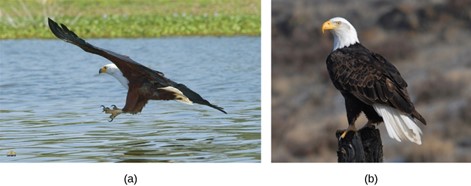
Figure 1: The (a) African fish eagle is similar in appearance to the (b) bald eagle, but the two birds are members of different species. (credit a: modification of work by Nigel Wedge; credit b: modification of work by U.S. Fish and Wildlife Service)
Biological Species Concept
The most well-known species concept is the Biological Species Concept, which was proposed by evolutionary biologist Ernst Mayr. The biological species concept states that a species is a group of actually or potentially interbreeding natural populations which are reproductively isolated from other such groups. Reproductive isolation can be prezygotic, meaning that individuals of different groups do not mate with each other, or postzygotic, meaning that individuals of different groups mate together, but they are not able to produce offspring that are viable (able to survive) and fertile (able to reproduce).
In some cases, the biological species concept is straightforward and easy to apply. For instance, the western meadowlark (Sturnella neglecta) and the eastern meadowlark (Sturnella magna), both shown in Figure 2, respectively inhabit the western and eastern halves of North America. Despite the fact that their breeding ranges overlap throughout many upper midwestern states, including Michigan, Wisconsin, Illinois, Iowa, Missouri and Minnesota, the two groups do not interbreed. The courtship songs of the males of each species are distinctly different and females of each species respond to the songs of the males of their own species, leading to strong reproductive isolation between the two groups despite a high degree of similarity in appearance.
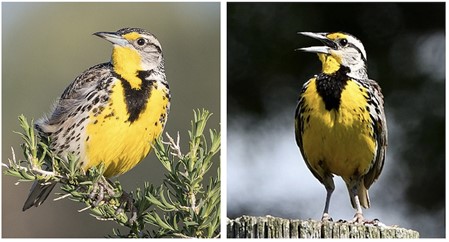
Figure 2: Males of the western meadowlark, Sturnella neglecta (left) and the eastern meadowlark Sturnella magna (right). Images from Wikimedia Commons
In many cases, however, the biological species concept is difficult or impossible to use. For example, the definition’s focus on interbreeding means this concept cannot be applied to asexual organisms, such as bacteria. Additionally, it can only be applied to groups for which detailed reproductive data are available, or at least obtainable. It is therefore impossible to apply the biological species concept to long-extinct species for which reproductive data do not exist and can no longer be obtained. It can also be difficult to apply the biological species concept to groups for which little is known about their reproductive biology or behavior. In these cases, extensive research would be required to determine the degree to which individuals do or do not interbreed with other groups before being able to clearly identify species boundaries.
Additionally, some groups have complex patterns of reproductive connectivity and isolation, such as the Ensatina salamander group (Fig 3). Systems like Ensatina are termed ring species because they form a ring around a particular geographic barrier, in this case, California’s Central Valley. As the group spread around the valley, populations maintained reproductive connectivity (ie. interbreeding) with nearby populations, but developed reproductive isolation from geographically distant populations. In the diagram below, interbreeding is shown as a gradation in color between two populations and reproductive isolation is shown as a solid line. For example, E. oregonensis (in red) can interbreed with E. picta (orange), E. xanthoptica (yellow), and E. platensis (pink), but none of the other species. Similarly, E. xanthoptica (yellow) can interbreed with E. eschscholtzii (green) and E. oregonensis (red), but none of the other species. In this case, the biological species concept leads to nonsensical and contradictory conclusions: E. oregonensis, E. xanthoptica, and E. eschscholtzii are members of the same species, but E. oregonensis and E. eschscholtzii are different species.
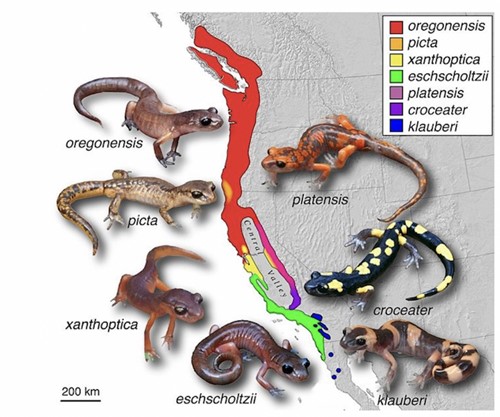
Figure 3: Range map for Ensatina species on the western coast of North America. Gradations in color (ex: E. oregonensis and E. picta) denote interbreeding between the two species, while solid lines (ex: E. klauberi and E. escholtzii) denote reproductive isolation. Image from Wikimedia Commons.
A ring species is a unique biological phenomenon that occurs when a species exists as a series of populations encircling a geographic barrier or obstacle, such as a mountain range or body of water. In a ring species, neighboring populations can interbreed successfully, but as you move along the ring and the populations gradually accumulate genetic differences, the individuals at the endpoints of the ring may no longer be able to interbreed due to the accumulation of genetic changes and the resulting reproductive isolation.
The concept of a ring species challenges traditional notions of species boundaries because, in a classical sense, members of the same species are expected to be able to interbreed and produce fertile offspring. In a ring species, however, the populations at the far ends of the ring have diverged to the point where interbreeding is no longer possible, yet intermediate populations can still interbreed with their neighbors.
Ring species provide a unique example of how geographic and ecological factors can interact with genetic divergence to create a continuum of variation within a population. They demonstrate how populations can gradually accumulate genetic changes over space and time, leading to reproductive isolation and the potential for speciation.
Another example of a ring species is the Larus gulls (Herring gull complex) found around the Arctic region. The gulls form a continuous ring around the North Pole, with interbreeding possible between neighboring populations but not between those at the endpoints of the ring.
Overall, ring species highlight the complexity of the speciation process and challenge our conventional understanding of species formation and reproductive isolation.
The Phylogenetic Species Concept
Due to the limitations of the biological species concept described above, other species concepts have been developed. The phylogenetic species concept defines species as groups of organisms that share a pattern of ancestry and descent and which form a single branch on the tree of life (Fig 4). This concept focuses more on the evolutionary history that has shaped the species as we see it today, and increasingly relies on genetic data to assign individuals to species. The phylogenetic species concept resolves some of the problems of the biological species concept since it can be applied to asexual species and those for which detailed reproductive behavioral data are unavailable. Its reliance on genetic data makes it also difficult to apply to long-extinct species; however, recent advances in genetic analysis have allowed scientists to extract DNA from recently extinct organisms such as Neanderthals and wooly mammoths. Scientists using the lineage species concept must still consider what type and magnitude of genetic differences, and in what portions of the genome, constitute different species and must employ modern computational tools to manage the increasingly large datasets produced in genetic analyses.
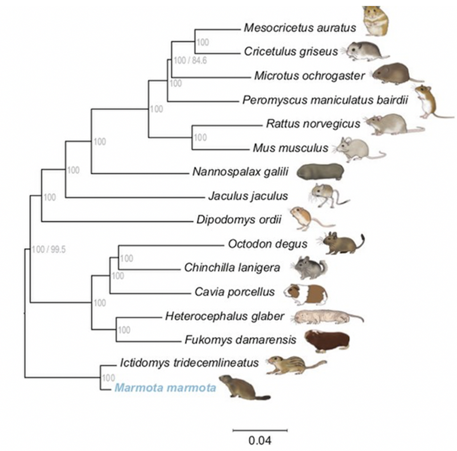
Figure 4: A phylogenetic tree of the order Rodentia (rodents), representing the lineage species concept’s focus on species being identified as unique branches on a phylogenetic tree. Image from Wikimedia Commons
The Morphological Species Concept
How do scientists define species in groups where there is limited or unavailable data on reproductive behavior or genetic similarity? Consider, for example, the two trilobites shown in Figure 5. Both of the fossils shown in the figure are members of the Order Phacopidae, which went extinct during the end-Devonian mass extinction event that occurred approximately 360 million years ago. Consequently, the only evidence that remains of their existence is fossils; there is no behavioral data on reproductive isolation or connectivity with other trilobites and the fossils are old enough that their DNA has degraded beyond our current analytical capabilities. How then, do we define species in trilobites? The morphological species concept is frequently applied in such cases, as it relies entirely on morphology (the physical structures or traits of an organism).
As you look at two photos in Fig 5, you will notice clear morphological differences. The fossil on the right has large spines jutting from both its head and rear ends (in trilobites, these are termed the cephalon and pygidium, respectively). Additionally, the spines along the side of the trilobite’s thorax are much larger and more pronounced in the fossil on the right. These morphological differences lead us to categorize these fossils as members of different species. In this case, the differences are large enough that we even categorize these fossils as members of different genera and families.

Figure 5: Two trilobites in the order Phacopidae; Hollardops mesocristata (left) and Cheirurus ingricus (right). Images from Wikimedia Commons
Since all organisms have physical traits, the morphological species can be used on any group of organisms on Earth. The major limitation to this species concept, however, is that morphology can be very misleading. Consider, for example, the shark and dolphin shown in Figure 6. These organisms have many morphological similarities in their body shape and coloration; however, we know from genetic analyses and more detailed morphological studies (on internal structures, etc) that sharks are more closely related to rays and other fish and dolphins are more closely related to whales and other mammals. The similarities that we first notice in these organisms are due to the similarities in the marine environment in which both organisms live and not to relatedness between the organisms. Consequently, the morphological species concept is often only used when other species concepts cannot be applied (for example, in the trilobate case) or in conjunction with other species concepts described above.

Figure 6: A bullshark (Carcharhinus leucas, left) and a bottlenose dolphin (Tursiops truncates, right). Images from Wikimedia Commons
Other Concepts: Ecological Species & Phenetic Species
Recall that ecology is the study of organisms and their interactions with the environment. Each species occupies a niche that in part is dictated by their interaction and competition with other species, that is the realized niche. When we consider the ability of organism to successfully occupy their own ecological niche or habitat, including their use of resources and impact on the environment, we can consider these as ecological species.
The ecological species concept is a newer concept that is not used as often as the others described above. Still, it can be very useful if you are seeing organisms that look similar to one another in nature, but they are eating different foods and/or living in different habitats. You would know these organisms to be different ecological species as a result.
Scientists sometimes only focus on the physical traits of organisms, regardless of their niche or their ability to mate with one another. If we have a set of organisms that are phenotypically similar and that look different from other sets of organisms we are grouping organisms as phenetic species. If you have these similar looking organisms separated in different habitats and/or they don’t mate with one another, we would still use the term phenetic species to describe them.
Linking Species Concepts
Most scientists generally agree that a species is a group of organisms that share an evolutionary and ecological history and that are distinct from other groups. The primary difference in the species concepts described above is the forms of evidence used to quantify those differences and to categorize individuals as members of a particular species. The biological species concept relies on behavioral data and emphasizes reproductive isolation between groups. The lineage species concept relies on genetic data and emphasizes distinct evolutionary trajectories between groups, which result in distinct lineages (branches on a phylogenetic tree). The morphological species concept relies on morphological data and emphasizes groups of physical traits that are unique to each species. These lines of evidence are not mutually exclusive and so multiple species concepts may be used together to define species boundaries. Regardless of the species concept used, not all organisms are easily categorized into distinct groups and so conversations around species concepts, species boundaries, and the evidence used to define them are a dynamic field of evolutionary biology.
How Speciation Occurs
As mentioned above, macroevolution can occur gradually or more rapidly in punctuated events. Darwin envisioned the gradualism most often associated with speciation. Darwin envisioned this process as a branching event and diagrammed the process in the only illustration in On the Origin of Species (Fig 7a). Compare this illustration to the diagram of elephant evolution (Fig 7b), which shows that as one species changes over time, it branches to form more than one new species, repeatedly, as long as the population survives or until the organism becomes extinct.
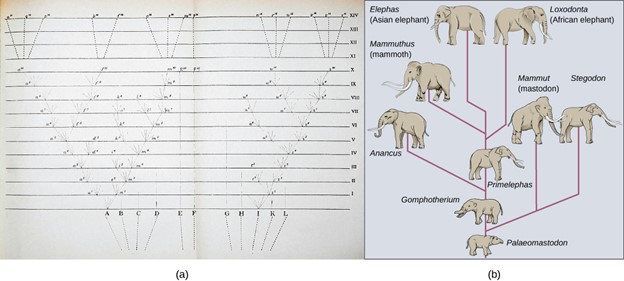
Figure 7: The only illustration in Darwin’s On the Origin of Species is (a) a diagram showing speciation events leading to biological diversity. The diagram shows similarities to phylogenetic charts that today illustrate the relationships of species. (b) Modern elephants evolved from the Palaeomastodon, a species that lived in Egypt 35–50 million years ago.
Types of Speciation
For speciation to occur, two new populations must form from one original population and they must evolve in such a way that it becomes impossible for individuals from the two new populations to interbreed. Biologists have proposed mechanisms by which this could occur that fall into two broad categories. Allopatric speciation (allo- = “other”; -patric = “homeland”) involves geographic separation of populations from a parent species and subsequent evolution. Sympatric speciation (sym- = “same”; -patric = “homeland”) involves speciation occurring within a parent species remaining in one location (Fig 8).
Another category called peripatric speciation (peri = “around or near” ; -patric = “homeland”) is similar to sympatric speciation in that there is no physical barrier that separates two subpopulations from each other at first. What is special in the case of peripatry is that the subpopulation is isolated from the rest of the group moving to a new niche and then becomes isolated and is no longer able to return to the larger population (Fig 8). This subpopulatin is small in size, and genetic changes can occur quickly with the subpopulation can drift rapidly leading to speciation.
Parapatry speciation is similar to sympatric speciation as well; however, the amount of area in which these organisms in question would cover is very small (Fig 8). Organisms that fall into this category tend to be very stationary and/or move very short distances. The “para” references “besides” because this type of speciation is occurring in a very small area. A well-known example of parapatry occurs in population of the grass Agrostis tenuis which span mine tailings of soils with heavy metals. There is a genetic trait for tolerance to the heavy metals. Gene flow can occur between sub populations on and off mine tailings (in normal and polluted soils) but hybridization is prevented since the following time is off between these areas.
Biologists think of speciation events as the splitting of one ancestral species into two descendant species. There is no reason why more than two species might not form at one time except that it is less likely and we can conceptualize multiple events as single splits occurring close in time.
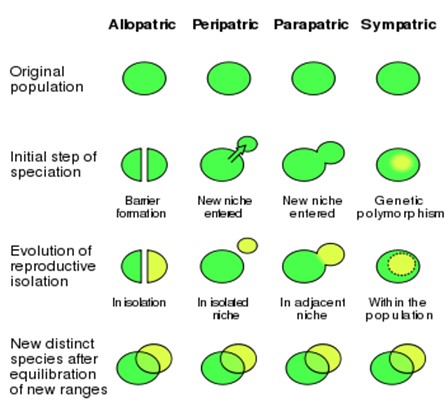
Figure 8: The different types of speciation that results in a new species (shown in yellow) being carved out from the original species population (shown in green). Ilmari Karonen, CC BY-SA 3.0.http://creativecommons.org/licenses/by-sa/3.0/, via Wikimedia Commons
Allopatric Speciation
A geographically continuous population has a gene pool that is relatively homogeneous. Gene flow, the movement of alleles across a species’ range, is relatively free because individuals can move and then mate with individuals in their new location. Thus, an allele’s frequency at one end of a distribution will be similar to the allele’s frequency at the other end. When populations become geographically discontinuous, it prevents alleles’ free-flow. When that separation lasts for a period of time, the two populations are able to evolve along different trajectories. Thus, their allele frequencies at numerous genetic loci gradually become increasingly different as new alleles independently arise by mutation in each population. Typically, environmental conditions, such as climate, resources, predators, and competitors for the two populations will differ causing natural selection to favor divergent adaptations in each group.
Isolation of populations leading to allopatric speciation can occur in a variety of ways: a river forming a new branch, erosion creating a new valley, a group of organisms traveling to a new location without the ability to return, or seeds floating over the ocean to an island. The nature of the geographic separation necessary to isolate populations depends entirely on the organism’s biology and its potential for dispersal. If two flying insect populations took up residence in separate nearby valleys, chances are, individuals from each population would fly back and forth continuing gene flow. However, if a new lake divided two rodent populations continued gene flow would be unlikely; therefore, speciation would be more likely.
Biologists group allopatric processes into two categories: dispersal and vicariance. Dispersal is when a few members of a species move to a new geographical area, and vicariance is when a natural situation arises to physically divide organisms.
Scientists have documented numerous cases of allopatric speciation taking place. For example, along the west coast of the United States, two separate spotted owl subspecies exist. The northern spotted owl has genetic and phenotypic differences from its close relative: the Mexican spotted owl, which lives in the south (Fig 9).
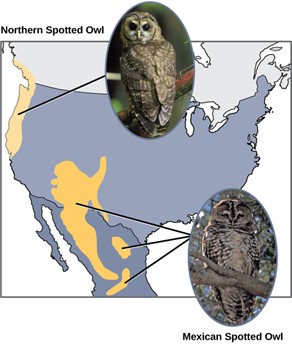
Figure 9: The northern spotted owl and the Mexican spotted owl inhabit geographically separate locations with different climates and ecosystems. The owl is an example of allopatric speciation. (credit “northern spotted owl”: modification of work by John and Karen Hollingsworth; credit “Mexican spotted owl”: modification of work by Bill Radke)
Additionally, scientists have found that the further the distance between two groups that once were the same species, the more likely it is that speciation will occur. This seems logical because as the distance increases, the various environmental factors would likely have less in common than locations in close proximity. Consider the two owls: in the north, the climate is cooler than in the south. The types of organisms in each ecosystem differ, as do their behaviors and habits. Also, the hunting habits and prey choices of the southern owls vary from the northern owls. These variances can lead to evolved differences in the owls, and speciation likely will occur.
In some cases, a population of one species disperses throughout an area, and each finds a distinct niche or isolated habitat. Over time, the varied demands of their new lifestyles lead to multiple speciation events originating from a single species. We call this adaptive radiation because many adaptations evolve from a single point of origin; thus, causing the species to radiate into several new ones. Island archipelagos like the Hawaiian Islands provide an ideal context for adaptive radiation events because water surrounds each island which leads to geographical isolation for many organisms. The Hawaiian honeycreeper illustrates one example of adaptive radiation. From a single species, the founder species, numerous species have evolved, including the six in Figure 10. Notice the differences in the species’ beaks. Evolution in response to natural selection based on specific food sources in each new habitat led to evolution of a different beak suited to the specific food source. The seed-eating bird has a thicker, stronger beak which is suited to break hard nuts. The nectar-eating birds have long beaks to dip into flowers to reach the nectar. The insect-eating birds have beaks like swords, appropriate for stabbing and impaling insects. Darwin’s finches are another example of adaptive radiation in an archipelago.
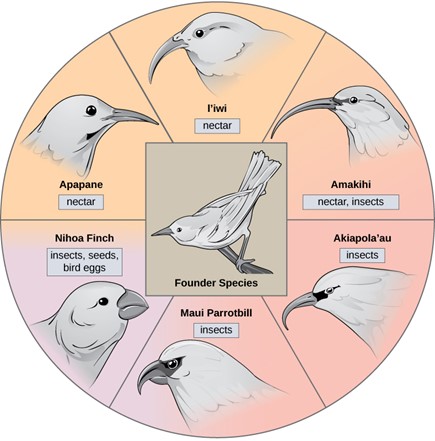
Figure 10: The honeycreeper birds illustrate adaptive radiation. From one original species of bird, multiple others evolved, each with its own distinctive characteristics.
Sympatric Speciation
Can divergence occur if no physical barriers are in place to separate individuals who continue to live and reproduce in the same habitat? The answer is yes. We call the process of speciation within the same space sympatric. The prefix “sym” means same, so “sympatric” means “same homeland” in contrast to “allopatric” meaning “other homeland.” Scientists have proposed and studied many mechanisms.
One form of sympatric speciation can begin with a serious chromosomal error during cell division. In a normal cell division event chromosomes replicate, pair up, and then separate so that each new cell has the same number of chromosomes. However, sometimes the pairs separate and the end cell product has too many or too few individual chromosomes in a condition that we call aneuploidy.
Polyploidy is a condition in which a cell or organism has an extra set, or sets, of chromosomes. Scientists have identified two main types of polyploidy that can lead to reproductive isolation of an individual in the polyploidy state. Reproductive isolation is the inability to interbreed. In some cases, a polyploid individual will have two or more complete sets of chromosomes from its own species in a condition that we call autopolyploidy. The prefix “auto-” means “self,” so the term means multiple chromosomes from one’s own species. Polyploidy results from an error in meiosis in which all of the chromosomes move into one cell instead of separating.
For example, if a plant species with 2n = 6 produces autopolyploid gametes that are also diploid (2n = 6, when they should be n = 3), the gametes now have twice as many chromosomes as they should have. These new gametes will be incompatible with the normal gametes that this plant species produces. However, they could either self-pollinate or reproduce with other autopolyploid plants with gametes having the same diploid number. In this way, sympatric speciation can occur quickly by forming offspring with 4n that we call a tetraploid. These individuals would immediately be able to reproduce only with those of this new kind and not those of the ancestral species.
The other form of polyploidy occurs when individuals of two different species reproduce to form a viable offspring that we call an allopolyploid. The prefix “allo-” means “other” (recall from allopatric): therefore, an allopolyploid occurs when gametes from two different species combine. Figure 11 illustrates one possible way an allopolyploid can form. Notice how it takes two generations, or two reproductive acts, before the viable fertile hybrid results.
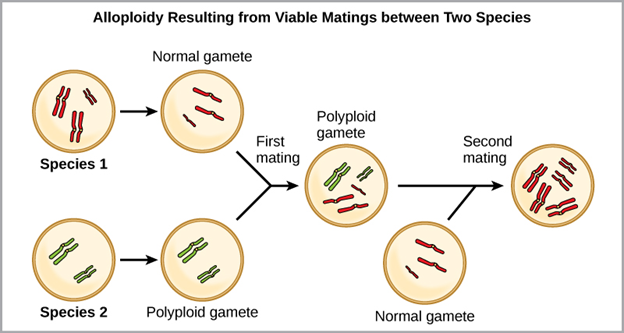
Figure 11: Alloploidy results when two species mate to produce viable offspring. In this example, a normal gamete from one species fuses with a polyploidy gamete from another. Two matings are necessary to produce viable offspring.
The cultivated forms of wheat, cotton, and tobacco plants are all allopolyploids. Although polyploidy occurs occasionally in animals, it takes place most commonly in plants. (Animals with any of the types of chromosomal aberrations that we describe here are unlikely to survive and produce normal offspring.) Scientists have discovered more than half of all plant species studied relate back to a species evolved through polyploidy. With such a high rate of polyploidy in plants, some scientists hypothesize that this mechanism takes place more as an adaptation than as an error.
Reproductive Isolation
Given enough time, the genetic and phenotypic divergence between populations will affect characters that influence reproduction: if individuals of the two populations were brought together, mating would be less likely, but if mating occurred, offspring would be nonviable or infertile. Many types of diverging characters may affect the reproductive isolation, the ability to interbreed, of the two populations.
Reproductive isolation can take place in a variety of ways. Scientists organize them into two groups: prezygotic barriers and postzygotic barriers. Recall that a zygote is a fertilized egg: the first cell of an organism’s development that reproduces sexually. Therefore, a prezygotic barrier is a mechanism that blocks reproduction from taking place. This includes barriers that prevent fertilization when organisms attempt reproduction. A postzygotic barrier occurs after zygote formation. This includes organisms that don’t survive the embryonic stage and those that are born sterile.
Some types of prezygotic barriers prevent reproduction entirely. Many organisms only reproduce at certain times of the year, often just annually. Differences in breeding schedules, which we call temporal isolation, can act as a form of reproductive isolation. For example, two frog species inhabit the same area, but one reproduces from January to March; whereas, the other reproduces from March to May (Fig 12).
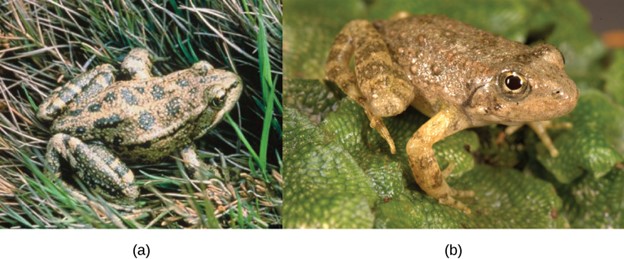
Figure 12: These two related frog species exhibit temporal reproductive isolation. (a) Rana aurora breeds earlier in the year than (b) Rana boylii. (credit a: modification of work by Mark R. Jennings, USFWS; credit b: modification of work by Alessandro Catenazzi)
In some cases, populations of a species move or are moved to a new habitat and take up residence in a place that no longer overlaps with the same species’ other populations. We call this situation habitat isolation. Reproduction with the parent species ceases, and a new group exists that is now reproductively and genetically independent. For example, a cricket population that was divided after a flood could no longer interact with each other. Over time, natural selection forces, mutation, and genetic drift will likely result in the two groups diverging (Fig 13).
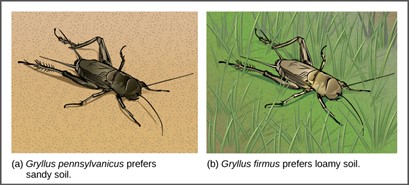
Figure 13: Speciation can occur when two populations occupy different habitats. The habitats need not be far apart. The cricket (a) Gryllus pennsylvanicus prefers sandy soil, and the cricket (b) Gryllus firmus prefers loamy soil. The two species can live in close proximity, but because of their different soil preferences, they became genetically isolated.
Behavioral isolation occurs when the presence or absence of a specific behavior prevents reproduction. For example, male fireflies use specific light patterns to attract females. Various firefly species display their lights differently. If a male of one species tried to attract the female of another, she would not recognize the light pattern and would not mate with the male.
Other prezygotic barriers work when differences in their gamete cells (eggs and sperm) prevent fertilization from taking place. We call this a gametic barrier. Similarly, in some cases, closely related organisms try to mate, but their reproductive structures simply do not fit together. For example, damselfly males of different species have differently shaped reproductive organs. If one species tries to mate with the female of another, their body parts simply do not fit together. (Fig 14).

Figure 14: The shape of the male reproductive organ varies among male damselfly species, and is only compatible with the female of that species. Reproductive organ incompatibility keeps the species reproductively isolated.
In plants, certain structures aimed to attract one type of pollinator simultaneously prevent a different pollinator from accessing the pollen. The tunnel through which an animal must access nectar can vary widely in length and diameter, which prevents the plant from cross-pollinating with a different species (Fig 15).
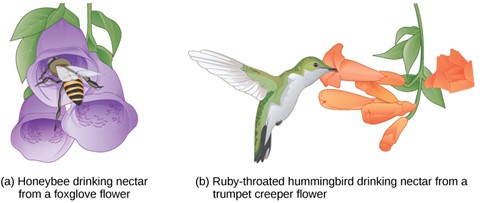
Figure 15: Some flowers have evolved to attract certain pollinators. The (a) wide foxglove flower is adapted for pollination by bees, while the (b) long, tube-shaped trumpet creeper flower is adapted for pollination by hummingbirds.
When fertilization takes place and a zygote forms, postzygotic barriers can prevent reproduction. Hybrid individuals in many cases cannot form normally in the womb and simply do not survive past the embryonic stages. We call this hybrid inviability because the hybrid organisms simply are not viable. In another postzygotic situation, reproduction leads to hybrid birth and growth that is sterile. Therefore, the organisms are unable to reproduce offspring of their own. We call this hybrid sterility.
Sympatric speciation may also take place in ways other than polyploidy. For example, consider a fish species that lives in a lake. As the population grows, competition for food increases. Under pressure to find food, suppose that a group of these fish had the genetic flexibility to discover and feed off another resource that other fish did not use. What if this new food source was located at a different depth of the lake? Over time, those feeding on the second food source would interact more with each other than the other fish; therefore, they would breed together as well. Offspring of these fish would likely behave as their parents: feeding and living in the same area and keeping separate from the original population. If this group of fish continued to remain separate from the first population, eventually sympatric speciation might occur as more genetic differences accumulated between them.
This scenario does play out in nature, as do others that lead to reproductive isolation. One such place is Lake Victoria in Africa, famous for its sympatric speciation of cichlid fish. Researchers have found hundreds of sympatric speciation events in these fish, which have not only happened in great number, but also over a short period of time. Figure 16 shows this type of speciation among a cichlid fish population in Nicaragua. In this locale, two types of cichlids live in the same geographic location but have come to have different morphologies that allow them to eat various food sources.

Figure 16: Cichlid fish from Lake Apoyeque, Nicaragua, show evidence of sympatric speciation. Lake Apoyeque, a crater lake, is 1800 years old, but genetic evidence indicates that a single population of cichlid fish populated the lake only 100 years ago. Nevertheless, two populations with distinct morphologies and diets now exist in the lake, and scientists believe these populations may be in an early stage of speciation.
Rates of Speciation
Scientists around the world study speciation, documenting observations both of living organisms and those found in the fossil record. As their ideas take shape and as research reveals new details about how life evolves, they develop models to help explain speciation rates. In terms of how quickly speciation occurs, we can observe two current patterns: gradual speciation model and punctuated equilibrium model.
In the gradual speciation model, species diverge gradually over time in small steps. In the punctuated equilibrium model, a new species undergoes changes quickly from the parent species, and then remains largely unchanged for long periods of time afterward (Fig 17). We call this early change model punctuated equilibrium, because it begins with a punctuated or periodic change and then remains in balance afterward. While punctuated equilibrium suggests a faster tempo, it does not necessarily exclude gradualism.

Figure 17: In (a) gradual speciation, species diverge at a slow, steady pace as traits change incrementally. In (b) punctuated equilibrium, species diverge quickly and then remain unchanged for long periods of time.
The primary influencing factor on changes in speciation rate is environmental conditions. Under some conditions, selection occurs quickly or radically. Consider a species of snails that had been living with the same basic form for many thousands of years. Layers of their fossils would appear similar for a long time. When a change in the environment takes place—such as a drop in the water level—a small number of organisms are separated from the rest in a brief period of time, essentially forming one large and one tiny population. The tiny population faces new environmental conditions. Because its gene pool quickly became so small, any variation that surfaces and that aids in surviving the new conditions becomes the predominant form.
Summary
Speciation or macroevolution is the process by which new species arise from existing ones. It occurs due to the accumulation of genetic changes over time, leading to reproductive isolation between populations. There are two primary types of speciation: allopatric speciation and sympatric speciation.
- Allopatric Speciation: Allopatric speciation occurs when a population becomes geographically isolated from the rest of its species by a physical barrier, such as a mountain range, river, or ocean. The isolated populations experience different environmental conditions and evolutionary pressures, leading to genetic divergence. Over time, the accumulated genetic differences may prevent individuals from the separated populations from successfully interbreeding, resulting in the formation of new species. Allopatric speciation is a common mode of speciation, especially in cases where geographical barriers play a significant role.
- Sympatric Speciation: Sympatric speciation involves the emergence of new species within the same geographic area without any physical barriers. This type of speciation typically requires the evolution of strong reproductive barriers that prevent gene flow between populations. Sympatric speciation can be driven by various factors such as niche specialization, disruptive selection, and polyploidy (an increase in the number of sets of chromosomes). This process is considered more complex and less common than allopatric speciation but provides insights into the evolutionary potential within a shared environment.
There are other forms of speciation, and there is evidence for all types. All forms of speciation contribute to the diversity of life on Earth. The rate at which such speciation occurs varies as well. Gradualism suggests that evolution occurs through a continuous and gradual accumulation of small changes in populations over long periods of time. According to this theory, species evolve steadily and linearly, with traits slowly changing and accumulating in response to environmental pressures. Gradualism is often depicted as a smooth and constant process, resulting in the slow transformation of species into new forms. This theory aligns with Charles Darwin’s original concept of evolution by natural selection. Punctuated equilibrium, proposed by paleontologists Stephen Jay Gould and Niles Eldredge, challenges the idea of gradualism. This theory suggests that most species exhibit relatively little change over long periods of time (equilibrium), with short bursts of rapid change (punctuation) occurring during speciation events. These periods of rapid change are thought to be driven by significant environmental shifts or other factors that create new selective pressures. Punctuated equilibrium suggests that species remain relatively stable for most of their existence, with rapid and sometimes dramatic changes happening in relatively short periods. These two theories represent different ends of the spectrum and like speciation, there is evidence for both occurring.
What is most significant for establishing new species, regardless of the pace, is reproductive isolation. This key concept in evolutionary biology and refers to the mechanisms that prevent or limit gene flow between populations, leading to the independent evolution of distinct lineages. Reproductive isolation can occur through various mechanisms, both before and after mating, and it is essential for maintaining the genetic integrity of species.
Prezygotic reproductive barriers occur before the formation of a zygote (fertilized egg) and prevent mating or successful fertilization between different species or populations. Examples include:
- Geographic Isolation: Physical barriers like mountains, rivers, or oceans prevent individuals of different populations from mating due to their inability to access each other’s habitats.
- Temporal Isolation: Species with different mating seasons or times of activity are less likely to encounter each other, reducing the chance of successful mating.
- Behavioral Isolation: Differences in courtship behaviors, mating rituals, or vocalizations can prevent individuals from recognizing or responding to potential mates of other populations.
- Mechanical Isolation: Morphological differences, such as variations in genitalia, can prevent successful mating attempts between populations.
Postzygotic reproductive barriers come into play after fertilization has occurred and prevent the production of viable or fertile offspring. Examples include:
- Hybrid Inviability: Hybrid embryos do not develop properly or cannot survive after fertilization.
- Hybrid Sterility: Hybrid offspring may develop but are sterile and unable to reproduce.
- Hybrid Breakdown: First-generation hybrids may be viable and fertile, but subsequent generations experience reduced fitness or sterility.
Reproductive isolation is crucial for speciation because it leads to the accumulation of genetic differences between populations over time. As gene flow is limited or prevented, each population evolves independently in response to its specific environment and selective pressures. Over generations, these genetic changes can become more pronounced, resulting in the emergence of distinct traits and adaptations that define separate species. Reproductive isolation is therefore a driving force behind biodiversity, allowing for the creation of new forms of life through the divergence of populations.
Questions
Glossary
References
Kosal, E. 2023. Ring species and summary. North Carolina State University.
Limeri, L. Species Concepts. Introductory Biology 2.
University of Minnesota. Introductory Biology: Evolutionary and Ecological Perspectives.

